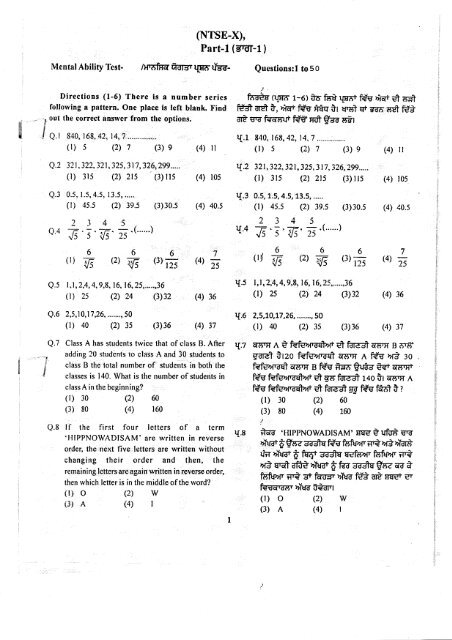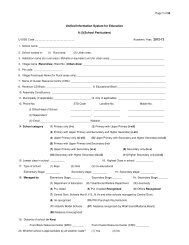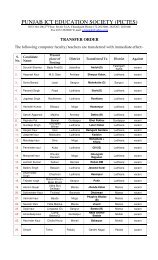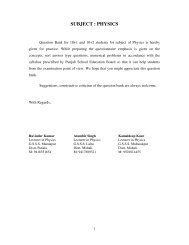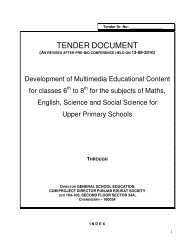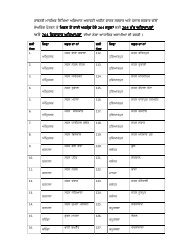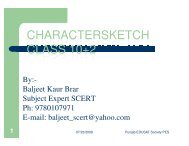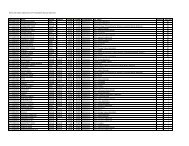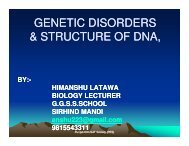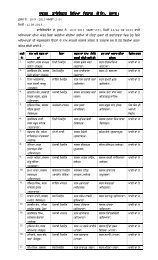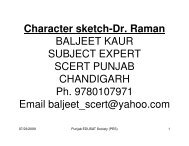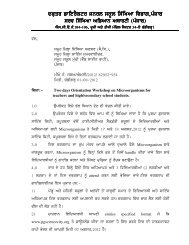Q 1 F't' tF' - SSA Punjab
Q 1 F't' tF' - SSA Punjab
Q 1 F't' tF' - SSA Punjab
You also want an ePaper? Increase the reach of your titles
YUMPU automatically turns print PDFs into web optimized ePapers that Google loves.
(NrsE-x),<br />
Part-I (UVr-t;<br />
MenialAbility Test-<br />
/Hrdfrr{ trdrgrWrdrfiila- euestions:l toso<br />
w<br />
t<br />
U<br />
Directions (1,6) There is a number serics<br />
follorving a pettern. Snc place is left blank. Find<br />
out the cnrrect answer from the options.<br />
f Q.l 840, 168, 42, 14, ? ..............<br />
{r} s (2) 7 (3) e (4) lt<br />
Q.2 321,322, 321,325,3 l'1,326,299.....<br />
(r) 3r5 (2) zls (3)lls (4) r05<br />
Q.3 0"5, 1.5,4.5, 13.5,.....<br />
( r) 4s.s (2) ie.s (3)30.s (4) 40.s<br />
!-"+ ^an<br />
Q 1<br />
<strong>F't'</strong> <strong>tF'</strong><br />
(t)<br />
6<br />
Vs<br />
667<br />
(2)<br />
'{6 (3) J;; (4) 't<br />
Q.5 1.1"2,4,4,9,9, 16, 16. 25,....."36<br />
(l) 2s (2) 24 (3)32 (4) 36<br />
Q.6 2-5,10,1 7,26,......,,50<br />
(r) 40 (2) 3s (3)36 (4i 37<br />
Q.7 Class A has students twice that of class B. After<br />
*{ adding 20 studcnts ro class A and 30 students to<br />
class B the total number of students in both the<br />
f<br />
classes is 140, What is the nurnber of students in<br />
class A in the beginning?<br />
{r} 30<br />
(3) 80<br />
a) 60<br />
(4) 160<br />
O.8 lf the first four letters of a term<br />
'|{IPPNOWADISAM' are rvritten in reverse<br />
order. the next five letters are written without<br />
changing their order and then, the<br />
remaining letters are again written in reverse order,<br />
then which letter is in the middle of the word?<br />
{1} o<br />
{3} A<br />
(2t w<br />
(4) I<br />
i.<br />
ffi (qrn 1-6) A6 fist r1r6i fd-s )ffi * r*<br />
ld,S a* t, limi f€s ffiq il ud ets06'sS tfS<br />
alt cq frErnr' f€S'E-d'Fa n8r<br />
{.L<br />
v.2<br />
840, 168,42,14, 7..............<br />
(r) s (2) 7 {3) e (4) il<br />
321.32?, 32t, 3?5, 3 t7, 326,?99.,..<br />
(l) 3t5 (?) 2t5 (3)lt5 (4) lOs<br />
q.3 0.5, 1.5,4.5, 13.5, .....<br />
(r) 4s.s t2) 3e.s (3)30.s (4) 10.5<br />
234 5<br />
_( )<br />
^- t)<br />
.\'.'...,<br />
6 667<br />
(rt (7) (3)<br />
-$<br />
(4)<br />
vs<br />
t?5 ?5<br />
i{.4<br />
E.;,s.,<br />
q.5 1,112,4,4,9,9, 16, 16, ?5,......36<br />
(r) 2s (2) 24 (3)32 (4) 36<br />
{.6 2,5,14,t7,26,......., 50<br />
(l) 40 t2) 3s (3)36 (4) 37<br />
{,7 alrrr A +*fu?rrsqb{r* ffiatrrff B 618'<br />
garct *rzo fieferr.s* qrr A Hs ry3 so<br />
feferfrdd E"srg B R fi.3:n gufs €qt ETrrBi<br />
fdvfufuaredryrd gFffi 14o it 616rr A<br />
fdb' f€ltryadrr{r dffiry<br />
Hs fsn? 3 i<br />
(r) 30 w 60<br />
(3) 80 (4) 160<br />
:<br />
{.s frw 'ruppNowADISAM' Err[? € qffi s6<br />
,hq A'<br />
gs" rrslq Ffu ffir'r ir* ari fiart<br />
tifr rftrd'tr W ytr€fts q'-ef6,?fr fuftP,t'iTr+<br />
'fg.q'd dfug*rcr,f fff e.r$s$rra ars *<br />
fuftpr'fr r€ sthimr nhfd F3 ofi rry e'<br />
fqsdrrdg' ailrs i*arr<br />
(2') w<br />
(r) o<br />
(3) A (4) |
i<br />
Q,9 ln the follorving letter series how many tirnes do<br />
'PQR' occui in suclr away that Q is in the middle<br />
ofP and R.<br />
QMPNPQRROPQNOPTQRPIUQROPQRPPRRPQRP =<br />
(r) 5 (2)6 (3) 4 t41 3<br />
Q.l0 How many 5'sarethcre in the followingsequence<br />
which are immediately followed by 3 but not<br />
imnrediately preceded by 7 ?<br />
8953253 8s56 S7 335't7 536s33s73 853<br />
(l) One (2) ]wo<br />
(3) Thrce (4) Four<br />
Q.ll Which word will appearlhird in dictionary?<br />
(r) BALLTUM (2) BALLISTICS<br />
(3) BALLERTNA (4) BALI-TSTITE<br />
Q.l2 Wlrich r.r,ord will appear Last in the dictionary?<br />
Latch<br />
(l) Laugh (2)<br />
(3) Laurels (4) Latitude<br />
Q.l3 lf -+ stands for addition.<br />
(- stands for subtraction,<br />
f<br />
!<br />
stands for division,<br />
stanils for multiplication,<br />
3 stands for equal to, lhen which of the<br />
fol Iowing alternatives is correct.<br />
tl) 2{5
Directions (Q. I 7- | 8)ln the following question there<br />
ffiF (r[Hir 1?-18] ]6'' fiR* qE5i'f#E HHl-dilt<br />
are equations without signs between each trvo nurnbers.<br />
g E Fn{l{'€i'e fr* ifs fsd rdt Ts, fti arg so<br />
Find out from the giren four options rvhich one would k{nn^ H' alfdts{<br />
rcnder the<br />
ffi e'-fa-g3r' HLIT Ag1 qh .r€".<br />
equation to the correct.<br />
ffi;r rr+drr ftm rs fa *{ H}nardr rs sr{1<br />
Q.l7 224'2 A+ A6 A13<br />
q.1? 22A^? AqA6A13<br />
(l) -,*,*,= (2) *. -, *, =<br />
(l) -, *, i. = (7) f, -, *, =<br />
(3) *, -, *, = (4) *, *, -, =<br />
(3) *, -, *" = (4) t,*,-,=<br />
l0At9AztA3A22<br />
r{.18 lO n t9 a 2t Lt Azz<br />
"Q.r8 (l) -, *, *, = (2) *, -, *, = (l) -,*,*,= (2) r, -, *,:<br />
(3) *, -, *, = (4) *, *, -, = (3) *, -, *, = (4) *, *, -, =<br />
Directions (Q" l9-2 | ) study the following frffeE (tltn?t' 19*21) i6if trst arS;rt66r'dt O<br />
infonnation to answer the given quegtions. ln a certain t{6i * gff td al*,r*r ffi *r g'x.r f+s o.rise and<br />
tras'fuhnrr;rter<br />
code language. "rise and shine" is wrirten by '935', "nice shinet' S' tt, "nica sun rise" $'219'<br />
sun rise" is written as "7l9" and "sun and moon" is written<br />
as '657'.<br />
g'st ]1<br />
ffifrilt ;Tie,r t Dri'osun and moon" fi osl ffi{D{t<br />
Q.l9 What is the code for 'Suno?<br />
t{.19 'Sun' Er *s * t*Afr l<br />
(r) s (2) 6 (3) 7 (4) I (r) s (2) 6 (3) 7 (4) |<br />
Q.20 Which of the follorving represents'moon rise'? q20 to, fttfifr?{i'H'fdirir fgq?su .moon rise' E<br />
(t) 7,1 (2) t,3 (3\ 6,7 (4) 9,6<br />
sdFrger a ?<br />
(l) 7,t (2) t,3 (3) 6,7 (4) 9,6<br />
Q.2l What does 'I' stands for?<br />
(l) nice (2) sun (3) rise (4) moon {.21 'l' fd86 6Fr€?E } I<br />
(lf nice (?) sun (3) rise (4) moon<br />
Q.?2 lf tree is salled green,<br />
V22 *ra er-Eng $ uo' fqg' fie, rf,<br />
green is called rain, rain is called rvater, water F ln" fE-{'<br />
is fi€, #T<br />
called air, air is called blue. Where 6 u'€? fffi're, ud<br />
do the fish 6 ir€r fuilr<br />
swim? fi€,Irg ir€r<br />
(l) water (2) rain (3) air (4) F dar failr r€<br />
blue<br />
ffiirt'ua'r<br />
g')Yd?r{i'fd€'<br />
(l) trrEl (2)}frfr (3) re' (4) Ets'<br />
Q.23 A family has a man, his wife, their 4 sons and their<br />
r{.23<br />
wives. The farnily of every<br />
Faubsil<br />
son also has 3<br />
Fs h ydr,mqrd,<br />
sons and<br />
vBlbd<br />
,rr3,<br />
' one daughter. Find out the total number of male<br />
$aai Arxt Lr3:6l,11i irct qft, _<br />
ye t Uf€A<br />
f#a<br />
members.<br />
f3a -gd')r{3' fEa d'i {f€q f#u drldn'<br />
' (r) I (2) t2<br />
HsaiSffirrg'efil<br />
(3) 4 (4) (l) I<br />
t7<br />
@12<br />
{3)<br />
Directions (Q24-25) read the following information<br />
4 (4) t7<br />
carefully and answer the questions which follows...<br />
ffi (qF6'24-2s) tai'ffrt aTS Hruq'd}g forra,<br />
Anupma.started from point<br />
6.'6 u*?rfg<br />
A, walked 7<br />
f€ dr} tgr. t$3-o<br />
m towards<br />
ffit<br />
the west. Took a left turn, rvalked 2m arrd reached point ** * re A 3 g{/rr ry dsuS z $a {er{ fr<br />
C. She then took a right turn and walked 4m to reach wS, gil.& trt lrs Ed lllii z rfra gfi; ftras fre c *<br />
q-fs<br />
point D. She then took a rigbt turn, walked<br />
a*€rF frd'Fi<br />
2m<br />
u'B'frs<br />
before<br />
afa,{' ar3' q }ia-gfls<br />
guiv q<br />
taking a final right tum and walking n i u$B ilsr fea<br />
3m before stopping at<br />
9u ** ufr lls ard<br />
'lti z<br />
deo gfr<br />
point<br />
tfg )tb){ #*<br />
B.<br />
q'B' {* 3 }fra iid }rr3ji{6<br />
Q.24 tlow<br />
€"s,ftl?uRroifu n Sdra$r "f3'<br />
farand forvards which directrbn is pointA trom<br />
point B.<br />
{.24 Qa ftt n"fe$E*br3turfwf*e ti<br />
(l) 6m lowards west (2) 8m towards east (1) o rfrasfa'{€F (2) 8 }fredyds€rr<br />
(3) lOm towards east (4) l0rn towards west (3) to lfralrds€s- (+l 10 3<br />
l*ata){d6
{J"35 ll'r\nu;:ma rvelks 2n torvards South fronr poini A 1i.25<br />
and reaches point E. Which ofthe follorving points<br />
(including E) rvould fall in a straight line?<br />
(2) A,D<br />
(r) A,B<br />
{3) B.C (4) C,D<br />
Q.26ln a certain code I{EVERSE is written as<br />
SI:WFSTF. llorv is F'ORWARD rvritten in that t{.26<br />
code?<br />
( r ) INQVQZ(r (2) CPSVBST1<br />
. (3) CPSXBSF (4) CPSXBSI<br />
Q.27ln a certain,codc language 'OU'IER' is coded as V2?<br />
'MSRCP' and S"t'lCK is coded as 'ORCAI'. In<br />
thc same cocle 'WHOLE' rvill be codcd as ......... ?<br />
(l) YJQNC (2) UFMCJ<br />
(3) UFJMC (4) UFMJC<br />
Q.28 lf SfiASONAL is written as E<strong>SSA</strong>NOLA, how can<br />
SHPARAI-E be written in that code?<br />
(r) SEAPARET (2\ ESPARATE<br />
(3) ESTTAAR'rE (4) ESAPARET<br />
*qa ufrnr. f$g n 3. z $-a Eird fer'€6<br />
gd* A rrrs fs-e E i u:ffi ir ta ffirr{t<br />
t€€- ffi' ftg ts rfi-$ fE{ ffrd tH'fds<br />
ffii<br />
(I) A,B (2) A,D<br />
{3) B,C (4) C,D<br />
ffi As s'rr €s REVERSE {'ffirrr;r:gr<br />
t st'wrsrr 9r aa f€s poRrvaRD f H<br />
fiFfrf,r{';ry$6p1<br />
(r) ENQVQZC (2)CpSVBSE<br />
(3) GPSXBSF (4)GPSXBSE<br />
ffi'fg grxr f€g .ourER' €rr ea.MsRcp'<br />
i rlr3 srrcK s d? .oncAr' il 9B'cE<br />
fds 'wHotE' s AF ofr i-gsr l<br />
(r) YJQNG (2) UFMCJ<br />
(3i UFJMC (4) uFMJc<br />
ESSaNOLA ffi44r;isr<br />
? 3t9fr' As f€s SEpARATE F ffi ftrFft{'<br />
g€srl<br />
(r) SEAPARET(2) ESFARATE<br />
(3)ESPAARTE (4) ESAPARET<br />
r{.28 frq? SEASONAL 6<br />
0.29In ccrtBfn code language RAC}IAVAN is written<br />
as CIARVAHNA. ln that code which word will be t{29<br />
written as MATIIAVAN?<br />
(r) IAMVAT{NA (2) TAMVAT{AN<br />
{3) ]Ar\,I|:TAVNA (4) MAI',VA}{NA<br />
Q.i.Olf in a certain code language BLOOD is r{'3g<br />
written as 241 I 3, BRUST is written as 26078, then<br />
{he code of ROI}UST is<br />
(t) 62078r t2) 612078<br />
(3) 678102 (4) 610732<br />
{.).31 In a certain "od*<br />
l*nguog* BROTHER is coded as u.31<br />
?456784,SISTHR is codcd as 9t9684, then what is<br />
the code for ROBBF,RS?<br />
(r) t82s22 (2) 4s626W<br />
(3) 921s784 (4) 4522849<br />
Q.32 In certain code language if TEA is writlen as 2051, ri.32<br />
'fhen COFFEE=?<br />
('l ) 36ss66 (2> 3r66s5<br />
(3) 3r5s66 (4) 315665s<br />
f isgwfr RncgavaNF fsftP:{ras't<br />
GARVAHNA. Sg'F F MAITIAVAN 6 ffi'<br />
r1q-g. ?t'i6 fltfifft frr+df1<br />
(r) TAMVAHNA (2) TAMVAHAN<br />
(3) TAMHAVjVA (4) MATVAHNA<br />
ffi Ar flr'f€s BLooD 6; zarr:, BRUsr ,<br />
$ zoota ffitlrr ster ir s ROnUST g Aa ,<br />
€rEl<br />
(1) 62078L Q) 612078<br />
(3) 678102 e' 6LO732<br />
ffi d's srnr fds BR0THER sr f'g<br />
2456784, SISTER g dB 919684 $ ROB-<br />
BERS s aa 6fr t+drr ?<br />
(r) t82s22 (2) 45626U<br />
(3) 9As7M (4) 4s22849<br />
ffi A's srxt k TEA il 2os1 mfirr iTier<br />
ft g' conFF.E:?<br />
(r) 365s66 (2) 3t66ss<br />
(3) 3tss66 (4) 3r5665s
Direetions (Q"33*40) what will come in place ofquestion<br />
nrark (?) in the following questions.<br />
e3i.# *F "#<br />
Q.35<br />
Q.l6<br />
--tr ._*tr --13<br />
(r) 3 (2) 4 (3)6 (+) e<br />
( r) 13 (2)<br />
(r) 22<br />
NE<br />
rfiT- r'I5T<br />
--lI -tI<br />
r0 (3) 08 (4) 06<br />
(3) ?6 (4) 24<br />
fta€:r,(q{6 33-40) tr m tg-rlt6r Wd fif6<br />
(?)SraYa?'t<br />
l'l lrl n<br />
r?<br />
r{.33 ^^ nTT- .-til fdTT- I ,4 fsl<br />
--E ---E<br />
{.34<br />
,{3s<br />
r{.36<br />
(r) 3 (2) 4 (3) 6<br />
(4) e<br />
n [il .n<br />
;-E ---E --T<br />
(r) 13 (2) ro (3) 08 (4) 06<br />
r# r# rf ---E b:J ta<br />
(l) 22 (2) 20 (3) 26 (4\ 24<br />
(t) 4<br />
(2) 2s<br />
(3) 64 (4) r00<br />
(t) 4<br />
(2) 2s<br />
(4) 100<br />
Q.37<br />
t{.3?<br />
Q.38<br />
(t)<br />
{t)<br />
20 (2\ 2s (3) l0<br />
ooo<br />
oo@oo<br />
ooooooo<br />
ooooo<br />
ooo<br />
s (2)6 (3) 8<br />
Q3e#@@<br />
(4) r5<br />
(4) 4l<br />
(l) 20 (21 2s (3) 10,<br />
q.38 OOO<br />
@ooeo<br />
@o@o@oo<br />
ooooo<br />
ooo<br />
(r) 5 (2) 6 (3) 8<br />
u.39<br />
(4) rs<br />
(4) 4r<br />
,@@#<br />
(r) l0 (?) 33 (3) 3s (4) 40 (r) 30 (2) 33 (3) 3s (4) 40
Q,40 r{.40<br />
B 4 E I L ,<br />
? c 6 H 13 1<br />
(r) J8Q (?) r6R (3) l3'l' (4) 20W<br />
Q.4l 'l'he diagranr gives the number of candidates who t{.41<br />
lhited in chemistry, Physics and English in different<br />
tests. The total numberofcandidates appeared rvas<br />
600. What is the percentage of candidates who<br />
f'ailed in atleast two subjects?<br />
Physics<br />
B 4 E I L 7<br />
3 c 6 H 13 ?<br />
(r) r8Q (2) r6R (3) l3T (4) 20w<br />
36. fg3" fap11' fd3:d- tr' $fisfri *,ffi<br />
q, €dngs A finr* aFfe-c fefapri6', *fsq<br />
f€fspr{6 ?,r3'frffi ? du-€q M fd$ es' ig<br />
irfl i{' ?ra,f€s g'dr f;E aB Bxteat d ds<br />
ffi 600 te sr €hrdi' $fuil-dr<br />
g1<br />
!f$Fr'<br />
rrs 6rt' ffi dP-lfe e kh,,{i' kS' ?s it imt<br />
;6qffinrn<br />
(r) l2"s (2) t.2s (3) l?.05 (4) t2<br />
Q.4? Four positions of a dice are given below ldentiff<br />
the nunrber<br />
ssss<br />
at the bottom when top's number is 6'<br />
(r) s (2) I (3) 3 (4) 4<br />
Q.43 Four viervs of one cube are given below. Each of<br />
the six faces ofcube is nunrbered',ln figure 3'which<br />
number will be opposite to the faee with number 3?<br />
(f) | (2\ 2 (3) 5 (4) 6<br />
Q.44 Which one of the follorving figures represents the<br />
relationship amongilebra" Grass eating animals, L-ions?<br />
(l )<br />
(2)<br />
(3)<br />
(4)<br />
fA^<br />
\"1 \-/<br />
@C<br />
a?f\<br />
\A/<br />
\i<br />
ooo<br />
(1) ta.s (2) t.zs (3) 12.05 (4) t2<br />
V.42 ftr* ffqfn'ur-dtd3ffi Sery*r-dune'-c,<br />
fif'g'arB ois't fm gqa rta fifir?{'5 A 3i'&*<br />
s* lrlq<br />
sss@<br />
u=rr d?l<br />
(r) s (?) I (3) 3 (4) 4<br />
r{.43 ffi ffr 6r rrrc ure.r$F'ffi g sd fe.F t-6'<br />
fCA drg ir6"l 6 urfxldt ffi ueq * *fi*,,{r 6d'<br />
t'* & fi#sr 8'.g ftid ktrs'ata s t Frstrt<br />
u'* dtorl<br />
r{.44 iE ffi{h{i f€f ftrrst fif,rd AEil, ulir trE<br />
erB ilr6€d xrg fr'd €s fsq €aTr€s tt<br />
(l)<br />
(2)<br />
(3)<br />
MMMM<br />
lst@l@l@l<br />
_-lt--tf<br />
-14j-<br />
-f-T)---(li--Gl-<br />
(r) | (2) 2 (3) 5 (4) 6<br />
(4)<br />
Oc<br />
CDC<br />
m<br />
coo
1<br />
Directions (Q.4547) study the following venn diagram<br />
carefully and answer the questions.<br />
ffi tqrs 4s-47) torfiJg aee6"fdsd Onp,ra;<br />
E'tr q',r3 fi93 drB qrm'€'9ro fegl<br />
Q.45 Which no. represents the girls doctor who are not<br />
leachers?<br />
(t) 7<br />
(3) e<br />
Q.46 Number 8 represents-<br />
(l) The doctors who are teachers also<br />
(2) onlydoctors<br />
(3) girls who are teachers<br />
(4) girls w'ho are doctors<br />
Q.4? Which no. represents girls wJro is teacher as well<br />
as doctor also?<br />
(r) e<br />
(3), I<br />
(2) 6<br />
t4) ls<br />
Directions (Q.48-52). The leters<br />
lorv follorv a definite patteren. Find out the missing letters<br />
to complete the pattern.<br />
Q.49<br />
-(l) aaab<br />
(3) bbba<br />
Q.50 m mm<br />
(l) mnmn<br />
(3) nmmm<br />
abba : bb- abbaa<br />
-<br />
(2) 6<br />
(4) 7<br />
b<br />
(2) - abab<br />
(4) baba<br />
n mmmn mmnrn<br />
(2) nnrun -<br />
(4) nrnrnn<br />
{.45 krE *e senfo?ii'Bqeir 9661ffi aft+r'rrc<br />
6r ir- 6 eax -tee.<br />
il<br />
(r)7 G\ 6<br />
(3) e (4) t5<br />
{.46 d6'g e"Frrger }-<br />
(1) aqdrzir frr$ ufq?,fqf4 d or<br />
(2) i*r aqec<br />
(3) sg*r,{i' ffi}di' rffrp?,rqrq o?t<br />
G) EFdtr,ti krs,,{'gqzir il6'<br />
\..41 f{flgt >rt*, r*dalr firuf,pr{i'adqrrnrd t{3.<br />
3f6rfi * ern'r eqEqe' il<br />
(l) e<br />
(3) I<br />
ftril€F (qrr 48-52) fu-t$ arBbhrdt' d<br />
rS fga ffies gu tF (pattern I i upm ir h grr<br />
err'E- uirr dir6 ttfr g;.rs aFtro'a riir<br />
(2)<br />
(4)<br />
Q.48a-cead-e-dceadc-<br />
(l) ddca (2) dcae<br />
(3) ccde (4) acde<br />
{.48 a-cead<br />
(l) ddca -e----dceadc- (2) dcae<br />
(3t ccde (4) acde<br />
bb- abbaa<br />
{.49 abba<br />
b<br />
(l) - aaab - (?) - abab<br />
(3) bbba (4) baba<br />
{.50 m-rnm-nmmmn-fimnm_<br />
(l) mnmn (2) nnmm<br />
(3) nmmm (4) nmmn<br />
6<br />
7
ENGLISH<br />
Q. X.5<br />
Read the following passsge and snswer the questions given after it.<br />
Jyoti lived with her mother in a small village.,From a young age she had witnessed her<br />
mother, a widow, being ill treated by the villalers. But when she was in high school she<br />
began to understand things, She couldnot take the insults to her mother any more. She<br />
decided to change the way widows were viewed in village society. Jyoti started a "Widow<br />
Empowerment Campaign". She spoke to village elders and knocked on two hundred<br />
doors to spread her message. She learnt io organize street plays which she used to make<br />
people aware about the plight of widows.<br />
Naturally her ideas were not acceptable to the society entrenched in aadirion. People<br />
pushed her out of their houses and refuserd to listen to what she had to say. But she went<br />
on relentlessly without faltering. Today, widows are allowed td'go out of their homes like<br />
others. M*y, including her mother are now employed at organisations and literacy<br />
centres.<br />
T.<br />
?<br />
3.<br />
The storyofJyoti is'an illustration of<br />
I. rigidity of traditional families.<br />
2. organisation of street plays. i<br />
3. the spread of employment opportunities forwidows.<br />
4. crusade of a young girl for social change.<br />
A major factor in Jyoti's success seems to be<br />
l. social and economic development programmes.<br />
2. sympathy and encouragement fi'om her mother.<br />
3. her own courage and detcrtnination.<br />
4, support from her friends.<br />
"She knocked on two hundred doors" indicates th* Jyoti<br />
l. went knocking at the doors one after the other.<br />
2, visited people at their houses individually. r<br />
3. approached a large number ofpeople.<br />
4. spoke to every family in the village.
.a<br />
4.<br />
The words 'entrenched in tradition' imply that villagers<br />
l. deeply believed in traditions.<br />
2. werc opposed to traditions,<br />
3. had begun to shed traditions.<br />
4, had begun to follow traditions.<br />
Jyoti's relentless campaign<br />
l. created an unrest.<br />
2. created a dent in society.<br />
3. left people untouched,<br />
4. created a revotution i<br />
Q.6-10<br />
Read the following passage snd answer the questions given after it.<br />
Designing toys f-or children is challenging yet stimulating. Considering the low attention<br />
span of today's kids, toys rvith higher play value are able to engage them longer. Yo.ung<br />
minds are also quite impressionable. So toy design has to be eonscious about ethics and<br />
values and also aid their cognitive, physical, emotiCInal and social skills. But above all, fun<br />
is the primary objective of play. Fun is what rnakes them come back for more; makes<br />
them learn and remember. Another erucial factor is eco-friendlines.s" Some of the best<br />
pro-environment design processes can actually be found in the lndian handicrafts industry.<br />
One such example is.the lathe-turned toy craft of Channapatna- a town near Bangaluru.<br />
The age old craft uses wood and colours made completely from naturat materials like<br />
turmeric, kumhrm, indigo, etc. Crealing modern desigrs based on such conventional<br />
techniques opens up a new range ofproducts that are unique, educational and organic.<br />
6.<br />
Toys are said to have a high play value wtren<br />
| . they present challenges to deslgnels-end to 6t ildr*n rvho play with them.<br />
2. they are costly but also have high quality.<br />
3. they are able to keep children's attention for long periods.<br />
4. they are used by a large number of children.<br />
The reference to the 'impressionable nature" of young children is to suggest that<br />
l. they are attracted to toys that are well designed and brightly coloured.<br />
2. their attitudes, values and ethics can easily be influenced by others.<br />
3. they like toys that help them learn and remember while having fun.<br />
4. they like toys which are small in size.
S- Toys that are considered eco-friendly are those that<br />
1. promote interest in preserving the natural environment.<br />
2. use natural materials.<br />
3. help the development of social skills.<br />
4. use high quality fibre.<br />
9. Which of the follorving is true for the toy cra of thannapatna?<br />
I. lt is famous for their beautiful shapes and bright colours.<br />
2. It is made by artificial materials.<br />
, 3. lt is based on modern design principles and efficient machines.<br />
:<br />
i<br />
4. It is an old and traditional practice.<br />
i t0. 'Fun is what makes them come back for more; makes them learn and remember.' means<br />
i<br />
t<br />
r<br />
L Children learn through fun and play.<br />
?. Children play more and more for fun.<br />
3. Children remember things while playing.<br />
4. Children learn onty through play.<br />
:<br />
f. {. ll-15 Read the follorving pBssage and answer the questions that follow.<br />
$ Years ago, people woke up to find sparows chiiping in their backyard. A noisy lot, they<br />
took grains right from your hand if you had befriended them. They got over their fear<br />
I<br />
1 easily and demanded food or water with their loud chirping if you had forgotten to give<br />
f- them their regular share of food. Tiny pink beaks opened to morsels of food or woms<br />
sometimes regurgitated by the parent birds. We had a splendid time watching the bird<br />
family bond and as children sat gazing at them as they picked up grain or splashed about<br />
us in muddy water.<br />
Many people have written poem$ and lyrics on sparows, their noisy chirps, their friendly<br />
nature, and their spotty feathers. Sparrows were a menace on the fields. There were guards<br />
with slings and stones to chase them away as they ate grain from standing crops. Now<br />
people are trying to woo them back to naturg.<br />
$ *dl<br />
ti<br />
,# .'<br />
t ,,',,.'<br />
frr<br />
i ,,.,:,''<br />
#.."':''<br />
#i<br />
#<br />
$i.:<br />
ffi<br />
$;<br />
s<br />
#i;,.,.,<br />
1..'.,,<br />
-.,<br />
I l.<br />
The author catls sparrow a friendly bird because<br />
l. they chirp in the backyard.<br />
2. they demand food.<br />
/<br />
3. they eat from our hand.<br />
4. they are with humans always.<br />
T: :::<br />
$s<br />
:."W..df #:' ;+;{::ii
12. Which of the following statements shows that watching sparows was fun for the author?<br />
l. Tiny beaks opened to morsels of food or wornii sometimes regurgitated by the parent<br />
birds.<br />
2' Children sat gazing at them as they picked up grain or splashed about us in muddy<br />
water,<br />
3. They demanded food or water with their loud chirping.<br />
4. They live nearour houses.<br />
13. The fanners considsr spaffows a nuisance because<br />
l. they are loud and noisy.<br />
2. they chirp loudly.<br />
3. they splash around in muddy warer.<br />
4. they eat up the grains from the fields.<br />
14, 'Regurgitated by the parent birds' means<br />
l. chewed and fed<br />
2. digested and brought back<br />
3, chewed and spatout.<br />
4, swallowed and brought back<br />
15. Sparrows have been a topic of interest for many...<br />
I. poets<br />
2. scientists<br />
3, farmers<br />
4. children
{h $eI"? Th* following five sentences come from r pamgroph. The first and the last se[tences<br />
are given, Choose the order in which the three sentenc€s (PQR) should appear to<br />
com plete the paragraph.<br />
:6, Sl One major problem that the world faces today is the rapid growth of population.<br />
S2<br />
s3<br />
s4<br />
55 This will cause serious problems of hunger and overcrowding!<br />
P<br />
- This is often referred !o as population explosion.<br />
Q - It is not so much the actual popuiation, but its increase that is alarming.<br />
R - Experts predict that by 2020 there will be about l0 billio:r people in the world.<br />
Choosefrom the options given below<br />
r. QPR<br />
2. PRQ<br />
3. PQR<br />
4. QRP<br />
lV.<br />
Sl Supposing you have to make a payment of Rs. 100, you could do so in coins.<br />
S2<br />
s3<br />
s4<br />
55 This paper money saves you a lot of tiouble and also saves precious metal.<br />
P - The person to whom the payment is being made would atso find it very<br />
tedious,<br />
Q - So the govemment gives you the alternative of paper money.<br />
R - But so many coins would be very cumbersome to'carry around.<br />
Choose from the options given below:<br />
l. RQP<br />
2. PRQ<br />
3. PQR<br />
4. RPQ<br />
.<br />
fr.<br />
&<br />
*<br />
&<br />
#<br />
#:<br />
M""'<br />
"<br />
v<br />
&<br />
&!<br />
*r:<br />
#<br />
s,:' ,::<br />
ffi,.<br />
$;r '<br />
H', ::<br />
#j.<br />
': ,ti"rJr"
Q. 18-19 Following questions have the second sentenrc tnissing. Choose the apprupriate<br />
sentence from ttre gi.ren opfionx to complete it<br />
18. A. Iv'lv sister and I have never ssen a house on fire before.<br />
B.<br />
C. We rushed out and saw fire blazing in the disiance.<br />
L We joined a large *owd of people who had gathered at the end of the sreet.<br />
3. One evenirrg when we heard fire engines rushing past my house.<br />
3. What a terrible scene we saw that day.<br />
4. We w*ent out with evervone.<br />
19. A. By ctimbing summit of Mount Everest you are overwhetmed by a deep sense of<br />
joy and thankfulness.<br />
B.<br />
C. The experience changes you completely and you are never the same again.<br />
l. lt is a joy thar lasts a lifetime.<br />
2. Yet, it is a fleeting moment.<br />
3. \'ou feel humiliated. )<br />
4. lt is a justification<br />
Q, 20-29 Choose ths \ilord rvhich best fills the blank from the four options given.<br />
20. lt is a good practice to the document oncs again before sending it for<br />
publication<br />
|. scan<br />
2. peer<br />
3. look up<br />
4. see<br />
21. When tlre teacher asked Ravi a question, he gave her a blank<br />
:<br />
l. gnze<br />
2. glare<br />
3. stare<br />
4. peek
22. She had her<br />
l, glance<br />
2. sight<br />
3. g;aze<br />
4. look<br />
23. If you<br />
l. notice<br />
2. view<br />
3. sight<br />
4. glimpse<br />
24. I caught a<br />
I. glare<br />
2. glance<br />
3. glirnpse<br />
"1. look<br />
fixed on the horizon.<br />
something amiss, please contact the authorities<br />
of him in the crowd for a fleeting moment before he disappear:ed.<br />
25. After the shipwreck, they were<br />
l. sleeping<br />
2. marooned<br />
3. guided<br />
4. found<br />
26" The landlord<br />
l. evicted<br />
2. posted<br />
3- forced<br />
4. shooed<br />
the tenet for not payingrent.<br />
on the island for three days.<br />
27. The village in the wake of tsunami, was a terrifying<br />
l. scenery<br />
:. scene<br />
3. landscape<br />
4. moment<br />
of a devastation.
28. The workers angrily voiced their<br />
l. preservation<br />
2. resentment<br />
3. initation<br />
4. resistant<br />
29. A fair-minded person is required to<br />
brothers.<br />
l. mediare<br />
2. interrupt<br />
3. intercept<br />
4. moderate<br />
to the management.<br />
the dispute between the two<br />
Q.30-35 Select the meaning of the given phrases/ idioms.<br />
30.<br />
Pulled up<br />
l. helped<br />
2. advised<br />
3. told<br />
4. scolded<br />
31.<br />
Keep up<br />
l. maintain<br />
2. leave behind<br />
3. confirm<br />
4. accept<br />
32.<br />
Carry on<br />
L start<br />
2. execute<br />
3. finish<br />
4. continue
33. Hand in glove<br />
l. in collusion<br />
2. holding opposite views<br />
3. warm and secure<br />
4. with friends<br />
34. Be in someone's shoes<br />
L wear shoes that do not belong to self<br />
2. be like them<br />
3. to pretend to be somebody else<br />
4. imagining oneself to be in another personrs situation<br />
35.<br />
Pull someone's leg<br />
l. to tease somebody<br />
2. to throw sornebody out<br />
3. to trip I person purposely<br />
4. to stretch someone's leg<br />
Q.36-{0 In the following pssssge there rre some numbered blanks. Fill in the blanks by<br />
selecting the most rppropriate word for each blank from the given options.<br />
At markets or at county fairs in old days, the customer had to be on guard against a<br />
-the<br />
a llni piliei<br />
packed<br />
a poke. Anyone who agreed to (40)<br />
dishonest trader. A house wife, for examptg wanting (36)<br />
_uly<br />
might be (37) a discount ifshe bought (38).<br />
ono, tied up in a small sack (39)<br />
a pig in a poke was naturally taking a risk<br />
36.<br />
l.<br />
.}<br />
J.<br />
4.<br />
for<br />
from<br />
into<br />
to<br />
37,<br />
l. served<br />
2. offered<br />
3. prefered<br />
4. liked<br />
ffiit#+M+:ailr;++:;ii\ ::=il:,,,::,:=i, i ii::::=i i.i ri
l. the<br />
2. an<br />
3.a<br />
4. some<br />
39.<br />
l. said<br />
2. known<br />
3^ called<br />
4. thought<br />
l. buy<br />
2. sell<br />
3. give<br />
4. eat<br />
10
Q.9l A ra;, of light goes fronr the mediurn of refractive<br />
index p, to a nredium of refractiye index p" . The<br />
an$le of incidence is i and the angle of refraction<br />
is r. Then (sin i/sin r) is equal to:<br />
{t} ilr Q', ltz<br />
(3) t\/lt2 (4) F:/ltr<br />
Q.9? A boy sitring or: the rop mosr herth in the<br />
Comparrment ofa trairr which isjust going to stop<br />
on the railway station, dn:ps an apple aiming at<br />
the cpen hand of his brother situated vertically<br />
belorv his hands at a disrance of about 2m, The<br />
apple will fall:<br />
{ l) In the hand of his b,rother<br />
(2) Slightly away fronr the hand of his brother<br />
in the direction of the motion of the train.<br />
{3) liligfirly away from rhe hands of his<br />
brorher in the direction opposite to the<br />
direction ofthe rnotion of the train.<br />
(4) None of these<br />
Q.93 In the following electric circuit, rvhat will be value<br />
of i, and ir?<br />
{,91 r€'{qrs * fEra?t F-{ H.fqm{ fnnE,bru€rss<br />
rirc !, 3 3 EC Hrfirlro{ hr err a*rgoe:;r rird<br />
p, i, er ed t r * rru=fr d-e i *ri ryrrgsfurs<br />
*e r,t s' (sin iAin r) faF € Enrrair i€ar. i<br />
(L) ',t41<br />
(3) p,,pt<br />
{2 l"tz<br />
(4) il:tlt<br />
r{.ez fu feisorm'} # A Qrro e'r* *a luertn; *<br />
+6't ffi rdr ffi Fiffi ig-{eers} iirt}u<br />
4rnr3 ts H' fw Bs Drqre yil + tsi f.ig<br />
E''ee"3 fi fc zr$-a d ge i fu,t-a, i r €F. f{<br />
frq f*e H"br ?<br />
( 1) 9F i sa' t iw fssl<br />
(2) 9F S'gr + fu,. f EH'kd, ua f*<br />
ddd*fertur<br />
(3) ?T e ya'i fu- i E-J' frfl lrf ffi<br />
Et aEfr dgll-a fur'€rl<br />
(4) kalH'i'*nfrr<br />
i<br />
{.e3 A6 trt ae M HirEra Eril qhc i. arS. i-d<br />
drrafr i'#r ' t<br />
(l) ',=;ft;t<br />
. i,= {' ,<br />
'<br />
I &+&<br />
(2) tl<br />
. R,+R,.<br />
(3) ,' =l-,<br />
t<br />
(4) None of these<br />
;, - =-&-y R,+R,<br />
,,=s&,<br />
Q.94 'Ihe human ear can detect continous sound in<br />
frequcncy range 201-lz to 20000 Ha Assume.speed<br />
of sound in air is 300mls for all<br />
frequencies.Calcu late the wave lengrh<br />
corresponding to the given €xtreme frequencies<br />
ofaudible range:<br />
( l) 6.5rnnr<br />
{3) ll6.5mnr<br />
(2)<br />
(4)<br />
l6.5mm<br />
6l.5mm<br />
15<br />
.R,<br />
(1),'=}lE,<br />
(2) 'r<br />
=<br />
*j;,<br />
(3)l=ry,<br />
(4) fwrtf*€'a$aiifr<br />
. .R,<br />
. lr= i<br />
R,+R,<br />
.R"<br />
. f'= ' I<br />
' & R,+4<br />
. R,+R,<br />
. Ir=-/<br />
t'R"<br />
{.e4 k Sifr *ir rsrgs 20Hz ? 20000 Hz }rrksl<br />
tTT ge 1re rrcrs t rfm lr€ ue, F-g apgr;1g<br />
arS loonvs r-ert. Df.H,,{,
Q.95 lfrve increase the velocity ofthe body by flrree tirnes<br />
what is the change in kinetic enerry?:<br />
(l) 3 tirnes<br />
(3) 2 times<br />
Q.96 An eleclric kettle is rated 230V,& 1000W. What<br />
is the resistance of its element?<br />
(l) 52,9 ohm<br />
{3) 529 ohm<br />
(2) 6 times<br />
(4) 9 times<br />
@<br />
5.29 ohm<br />
(4) 5290 ohrn<br />
Q,97 l'he wave lengths correspondingto violet, yeltow<br />
and.red lights are l.<br />
",<br />
i,, and .X, respectivelyitren:<br />
(l) L,>.Lr>L, (2) k,< hr< L,<br />
(3) Lr. hu( 1, (4) h,< L,< ).,<br />
Q.9S Thc imagc ol's cancllc is formccl by a convex tcns<br />
on a screen. lf the lolver half ofthe lens is painted<br />
black, to make it completely opaque. What rvill<br />
be the size and intensity of the image attained?<br />
(l) image same, intensity reduced<br />
(2) image and intensily remain same<br />
(3) inrage small, intensity same<br />
(4) imagc becomes bigger, intensity reduced<br />
i<br />
g.e5 fr-dnr ltrr y6 aEfr erl_s e? snr 3 qEr qqt EglU<br />
=t<br />
Qn et dfr;T gfi{'frr& grar eq fiedfrr<br />
(l) g aIEr<br />
. (3) rcl<br />
l2l 6 ql€r<br />
(4) q Erst<br />
{.e6 fs6r fqlld +sefr * eFdr zrov & | 000w t r fw<br />
* Fr{kdr (etemenr) d {d?rJ. ffila1 i€nfr t<br />
(1) 52.9 ohm (z',) 5.29 ohm<br />
{3) 529 ohm (4) 5290ohm<br />
{.97 rt*T ffi, r*er'ry-} ar's iidr S},{r ftrilci f;r6i<br />
S sirdr M L r I,ar3, ,t, A-? g'.<br />
(t) L,>Lr>L, (2) A,,< Lr< 2r,<br />
(3) Lr" Lu1 L, (4) hr< )1,< L"<br />
g.es, Ea.*HES s 11-SfsE gtnr #fr 1rrleil Fre-d6 g<br />
{'lrs a?sr ;dir f r ied #rfi e ffi- fiiF *.<br />
h{lr"rsdm E?rgs s* &a ro frs' fi€ si {fsfri<br />
g Frelg ?r{g gfqfg. g ar ra u€atr<br />
t UTdfrq s Erdhr g{t a}ar'??r$ s?s€'u?"<br />
t'ffi<br />
(2)fSfrstr3s?r€'gf Effi<br />
( g)<br />
\r$frs s E*fi Fd ry* Sr€' gfr atafr<br />
( 4 ) gSfrs s neh €sr llr} sr€' rI" F€dfr<br />
Q.99 The purpose of glass cover on top of a box-type<br />
solar cooker is to.......<br />
( l) Allow one to see rhe food being cooked<br />
(2i Allow more sunlight inro box<br />
(3i Prevent the ontry ofdust in the bor<br />
(4) Reduce heat loss by radiation<br />
Q. 100 A 60 kg man goes around the earth in a satellite.<br />
In the Satellite his weight will be?<br />
(l) 6ke<br />
(3) 60N<br />
{2) 7*ro<br />
(4) 600N<br />
Q.l0l The Principle on wlrich Generatsrworks?<br />
(l) Magnetism {2) Electricfield<br />
(3) Electro magletic (4) Flux<br />
lnduction<br />
Q.102 Tivo bodies with kinetic energies in ratir: 4: I are<br />
moving with equal linear monlentutn. The ratio of<br />
their masses is.<br />
(l) t:2<br />
(3) 4:l<br />
(2") l:l<br />
(4) l:4<br />
t6<br />
u.99<br />
fsa T*d s rd*<br />
fi€'A?<br />
( 1 ) sl *trs *in fa ffra, td fo'rr t faa#r<br />
l2I { fr go* *rr{i ffi fa}r{r€tr }rrrdr f+s<br />
)rreiI uilTr FEI<br />
t3) s i'gs ra rirs 6r iTr mral<br />
( 4) st fr ltrsdrft arorft Ertn sr iTr Ft I<br />
{.100 k{F,,ff$faryf;s oo ke igu*?er*f *<br />
,trgd [dg] g rrr8-ll]rd r$r frd'tr lfu6a t<br />
tru{Qrct srd fir6r t€orrf<br />
(1) 6kg<br />
(3) 60N<br />
!t.101 Fr?frr fuF fi{qts i *n vrs t<br />
(1) fiartku Q) feirlt$trd<br />
(t) t2<br />
(3X a:l<br />
(2) Zero<br />
14) 600N<br />
(3) fqlilfgqffitrs (4) €dqr<br />
{.102 g q=Jlt fr qirala rra6 ry*dr n'rrr 4: I },l6:rr':s<br />
d drkf,<br />
ft1r * ss il&,{r u?r I b t ffr<br />
gf },{E;qrsr ir€itrrl<br />
(2) l:l<br />
(4) 1..4
Q.103 lJrnpirical forrnula of compound is CI{;O. lts<br />
nrolecular mass is 60.1he molecular formula will<br />
be?<br />
(l) cH,o (2) C2H4O'<br />
(3) CaH6Ol (4) C4H$O4<br />
Q.104 Which ofthe follorving ions have l8 etecrrons, l9<br />
protons and 20 neutrens<br />
(l) Caz' (2) K*<br />
(3) Cr (1) S?-<br />
Q.105 Which of the tbllorving is an exampte ofcolloid<br />
(l) Vinegar (2) Mirk<br />
(3) Muddy water (4) Sugar Solution<br />
Q.106 fhe total number of electrons that take pa( in<br />
bond formation ofN. molecule.<br />
(l) 2<br />
(3) 6<br />
(2)<br />
(4)<br />
Q.107 A Compound contains six C-:H'ijonds, two C-C<br />
bonds and one C=O bond. 'fhe fbrnrula of<br />
compound is<br />
(t) I-rlccl.{,co()H (2)<br />
(3) H,CCOCH3 (4)<br />
Q.108 pHof0.00lMNaOHSolution is<br />
(r) il<br />
(3) t2<br />
4<br />
I<br />
(2) r0<br />
(4) e<br />
HrCOCI.ts<br />
HrccoocH.<br />
Q.109 Which substance rvill contain rnarimum numberof<br />
alorns<br />
(l) 4gm ofNaOH<br />
(3) 2gm of Il,<br />
(2) 4.4gm of CO,<br />
(4) 24gm ol'O,<br />
Q. I l0 Which one of follnwing should not be done<br />
( l) Placing dilute H-SO. in a Zn vessel<br />
(2) lllacing copper sulphate in Ag vessel<br />
(3) Placing dil H?SO. in copper vessel<br />
(4) Placing zinc sulphate solution in a<br />
copper vessel.<br />
Q.lll What is the mass percentage of hydrogen and<br />
oxygen in hydrogcnperoxide (l{,Oi)<br />
(l) s.88%;94j2%<br />
(2) 6.s8%;e3.t2%<br />
(3) 94.12o/a; 5.88%<br />
(4, 93.t2% ;6.88Yo<br />
t7<br />
r{.r03 *fd,{ s Lrs-r{u:l.r€t lr3ir cH?O Sr gre''<br />
r,'g gir oo 3I y ryg Ersd A'+dr<br />
(r) cH.o<br />
(3) C.H6O.'<br />
Q\ CrH402<br />
(4) C{H8O4<br />
19 fqrs ar9 eo @.a'e;<br />
12) rm ( 1) Ca2*<br />
K'<br />
( 3) ,cr<br />
( 4) 52'<br />
(3) 6<br />
{.104 fc,}rcr f?ffis },i"furit ffi' fur fs r 8 fuffry?cr,<br />
{,10s fr}rr. fuus H ffss d Qe'nre tr<br />
(tl frac'<br />
{:) frzthrlirr urat<br />
t{.106 N, Dfg fu fc fut<br />
ftg yar &? irr<br />
(1) 2<br />
tD fq<br />
t4) ts e. tfrg<br />
fr#dfs. fudr sd _e€<br />
(2) 4<br />
(4) I<br />
{.107 Fe as"fefa dfsr{ f€s e c-H $trrr, ? c-c<br />
tqr lr,rg.frq. C=O tca tr frfdT-s sr lrsa *<br />
{,10s<br />
( 1) 'H]CC'I{:COOH (2) HTCOCH3<br />
( 3) HsCCOCH] {4) HTCCOOCH.<br />
0"00t Fsr NaOH trrg * pH i€rfr<br />
( 1) ll (2) l0<br />
(3) tz (4) 9<br />
{.1o9 far rre'{s f€s Frr<br />
"<br />
fiprf'Er u-o{rgi il-dr<br />
( 1) 4gm of NaOI{ (U 4.4gmof CO,<br />
(3) 2gm ofH, {4) 24grn of o,<br />
{.11o ftTi H'EE Efr anf rairt v-eer<br />
1 1y irai* H:sO{ E ffo{ ? rcsa'€s ara'r<br />
121 erruil @ e tirs O' ei* t qrge'<br />
ffe ilrg<br />
i 3) Tsii HrSO.Ei a'rrd t Eit=r5 fro arfe,<br />
( 4) fu lrseetf,r g anrc tsrse fts atrs<br />
r{.111 F*5€Tr6 tra,{rernrr*s {H2O2) f€s rffre<br />
€'zrqfrrm elgfr Vftrs lr€irr rrg'afrr<br />
(1)i 5.EE% ;94.1?Yo<br />
(2) 6.88%;93.12%<br />
(3) 94. 12%;5.88%<br />
(4) 93.12o/o;6.88%
Q.l l? In the balanced equation the value of x and y are<br />
3Cu+..r lll.j0.,-+3Cu(NO3 ),+yNO+ 4 t{,0<br />
(l) 3.1<br />
(3) 8J<br />
(2) &0<br />
(4) 7,1<br />
follorving metal.<br />
(l) Cu (Copper)<br />
(3) Ni(Nikel)<br />
proteins and fats.<br />
(l) Stomach<br />
(3) Large Intestine<br />
{.112fi81d arrfefeq nsdz-s fr's x ,rr} v e" fl,<br />
i t 3Cu*x ltNO,+3Cu(N03)r+yNOr Ai,O<br />
( 1)t3,1 lD 8.6<br />
(3) 82 ( 4) 7,1<br />
Q.l l3 Alloy Gennan Silver does not contain one of the {.1r3 fuEfa-s<br />
ry aorrr fiffisd f{s ffi.qtr r*<br />
(2) Zn(Zine\<br />
t4) Ag(Silver)<br />
Q.l l4 Which partofthe human alimentarycanal, is the<br />
site for complete digestion of carbohyrJrates,<br />
(2) Smalllnrestine<br />
(4) Redum<br />
O,ll5 Which ol'the following pairs is incorrecrly<br />
matched?<br />
{l) Ligarnent-yellowelastietissue<br />
(2) Cartilage- aclipose connective iissue<br />
(3) lymph- fluid connecrive tissue<br />
t4) Bone-skcletolconnectiyetissue<br />
Q.ll6 Whiclr of'the following is not true about apical<br />
mcristem?<br />
(l)lt is present at rhe growing fips of<br />
stems and roots.<br />
(2) It brings about elongation ofdre stem and root<br />
(3) ft brings abouf seconda4y growtlr<br />
(4) lt brings abour prirnary growrh<br />
Q.ll7 Which part of the brain confrols co-ordinated<br />
rnove,nenfs of our body, sueh as riding a bicycle?<br />
il) Qerebrum<br />
(3) Medulla<br />
(2) Cerebellurn<br />
(4t Pons<br />
Q.l18 The correct order of the parts of a nerve cell<br />
through which anerve imputse is transmitted is.<br />
( I ) Nen e endings-dendrites-axon-cell body<br />
(21 Cell body-axon-dendrites-nerve e nrJings<br />
(3) Dendrites-nerve endings-cell body axon<br />
(4) Dendrires-cell body-axon-nerveendings<br />
Q.ll9 Which of the fbllowing cell organelle does not<br />
participate in cel lular division.<br />
(l) Ribosomes<br />
{?} Chromosomes<br />
(4) Nucleus<br />
rs<br />
(1) Cu Fqir)<br />
(3) Ni(ftao)<br />
l2', zn (Fmt<br />
(4) As (firs'?d)<br />
t{. 1 14 rdv d urye' ?rd e ffi fu* fts q,affiSz,<br />
rfd6'lrfg vd*, lr$ Jgr is;r,€ urr<br />
{1) fwsr 12) **"pea<br />
(3) €d1?r's6 (4) *drcx<br />
{.r15 to, fs'nr,{' H. ffi fr* s }irr rd rfr t r<br />
( t) ,kanta- $s'rs-*s'f"F<br />
tzl e-c*&x- +dtrjri$a far<br />
( 3) .F *q--strs' fr'tr f"f<br />
(4) ffi- fiffd fiffi fag<br />
{.116 ia ffipr awrr H' fa-agt fx.rrdt fr#rb{ s.e<br />
FSr$ a<br />
( r) b ser 3fr?i e fxfa,r. * xksiri m<br />
(2i b.-d ari tr{ et ffi €s s'tr<br />
qri sa<br />
{3) k rAS F"rqr rrt oir<br />
(4) fw {'farfr t€6r.F airE u?s'<br />
tf,117 F* rda f€q s'6*ar ?rr{r As ertfu{i.rtrtrsr<br />
iii+ rFclt-6 vF€F, ro{-dr g ffi, frfr. e,rr.o<br />
ftrrlqs aft*a{* Fri*}rf'. CI?r. I<br />
t l) frdEdH 12) ftdttsx<br />
(3) *':s6r (4) t?rm<br />
{.118 frB Fd nE f€s fr+sd;';} arjl ?s n s6f,<br />
Fr, f.sr srs?E Hs aad il<br />
n) a'r$ he - 3ffin -'irdF6 - fi6r#d<br />
(2) ft6 ni#d - ''tdlT6 - ffi - 6rS ffi<br />
(a) ffia<br />
- F.* fE-& - ftr rdd*dx.!i,<br />
(4) 3sfldffi - ntr r#d - llan'c ?r.* fi{e<br />
{.119 td fufi{rr{i'H. fuder i?r rtrdr *s.*a f€s<br />
gtaf ?r-fr Sigr?<br />
(3) Cytoplasm<br />
(2) ERrys-d<br />
l4') dstr{<br />
I8<br />
{ r) a,d!,fi'xr<br />
(s) H'fuawrrmf
Q.120 Cautam prepared a slide of thigh muscles of<br />
cockroach. What typc of muscles would he<br />
observB, when he views the slide under a<br />
microscope.<br />
( l) S.triated muscles<br />
(2) Non-striated nruscles<br />
(3) Both striated and non-striated muscles<br />
(4) Nervous tissue<br />
Q.t2l Which of the fotlowing statemenr is true abour<br />
dicotyledons.<br />
(l) 'l'heir root sysrem consists of similar<br />
fibrous roots<br />
(2) Theii lcaves have parallel venation<br />
(3) Their vascular bundles are arranged<br />
in a ring<br />
(4) Their flowers are trimerous<br />
Q.122 Which is the largest endocrine gland in human<br />
beings.<br />
(l) Pituitary<br />
(3) Thyroid<br />
(2) Adrenal<br />
(4) Parath.vroid<br />
fJ. 1 23 A plant has a body differentiated into root, stem &<br />
leaves, lt also has tissue for conduction of waterand<br />
olher substances, bul has naked embryo. Uncler<br />
which rypc will such plants bc classificd?<br />
( l) C.rmncsperrns (2) Angiospenns<br />
(i) llryophyta (4) Pteridophyta<br />
Q.124 Which part of the human oar converts pressure<br />
variations into electrical signals.<br />
( | ) tius.tach ian tutre (2') Auditory nerve<br />
t3) Ear drum (4) Cochlea<br />
Q.l?5 Choose the correct hierarchy in classification goup.<br />
( I ) Phylum-class-order-family-species<br />
(2) Phytum-order-class-family-species<br />
(3) Plrytum-class-family-order-species<br />
(4) Phylum-order-family-class-species<br />
Q.126 In which of thE following ways the number<br />
I 23456789 can be written as the product ofporvers<br />
of prirne numbers.<br />
(l) i2 x 3803 x3607<br />
(2) 72 x 3807 x 36A7<br />
(3) 13: x 3801 x 3601<br />
t9<br />
{4) I t2 x 3g l3 x 3813<br />
g.rzo msl{ * ffi-s t ira d?,{i' txir{r d mrda<br />
brrta Elstr rsds tr FH)reir,fr A?t" *r€ i<br />
Sr g far rga t iF rro o@'<br />
11y q'frrs efr<br />
t2) qddfosa*<br />
i J?, 96. trrd]-g'd t fg qtdf EfIilg df<br />
(4) 6I:s ftEr<br />
r{ -1 2 1 t6 ftrfrp{'' H' farrs. aeir e-*r ffi !f-el{'<br />
sfr rS ir<br />
( ri,,ffi d rq yd'd, tfu'd Ffl €"d<br />
a-i<br />
lEr T<br />
{2) r}fu"rr f€s H-}rr/rrrr€" €ftr€t r{dert<br />
usi<br />
( 3 i qldEfoa. fcg inuq€ gr$s-Ery irt rs<br />
{4) kr'?Bs"f$6ffigErs'<br />
:<br />
{.122 H{q f€ir rg 3r ffi'tr€? frFGt'ffi ffi<br />
tr<br />
{ r) fir-a*ad<br />
t3i qr*drfw<br />
(21 ,hr#rg<br />
(4) hs'eda'firs<br />
{,123 fsq tg Fr rg, sdr }rg tg *q *u runa s-r.<br />
fsx' f€v u''rfi brg ia urce €' fr'yrrd ud rrs,'s<br />
FiS * t ua h f€v qaa *;-d'uirrftF si e<br />
W far smil Hs r,reAl<br />
t 1)rfi+r8xrrarr<br />
(3) qYfe€sd"<br />
q.n* )rtrfr dra. pr fa6r gr6y Esn2f &rs'F kfirset<br />
her f*s rerrer 3r<br />
{t) Ux?fra+r@r e')<br />
(3) ftr er uirer (4)<br />
et 'f;fr€xu-sx<br />
(4) ?feffia<br />
E-J a,.S<br />
qrdr5thtr<br />
{.12s '€trdft ET6 a6nl * rS uaiT*S gEl<br />
( 1 ) 6d6lr-tdl- "r€d-fn-r.*<br />
(z] cr*r+r-bf icrir- f$-ga--Frd'<br />
t J) er$Fx-f4}-{r_rr;r6-E461<br />
( 4) a'dsn-ryrysa-dg-i-€1-fr€?<br />
rI:126<br />
tttrfr L234s6lgs F<br />
il€6cq' t gu fqs b fiab?{' H far:r r1;ar'7<br />
ffi, fufu Tr rrse at<br />
(1)'3!x3803 x3607<br />
(2') '?, x 380? x 360?<br />
{3) 13'? x 3801 * 3601<br />
(4) | l2 x 3813 x 38 l3<br />
nrsm frftp,fr€r S urrs *
Q. 137 A train Qovers a distance of480 km with a constant<br />
Q.128<br />
speed. lf the train runs with a speed 8km/hr less<br />
than the originat speed then it takes 3 hours more<br />
to cover fhe distance. Find the speed of the train<br />
(l) 60km/hr<br />
(3) S0knr/hr<br />
(-r0on__)'<br />
(2, 40km/hr<br />
(4) 30km/hr<br />
y.Lz7 fsa an d* +eo fa'#. et g# fse Flrrtr Er6<br />
Fr{r fu ilrS Atfrail ffi s6I fd.,}n'. rl-$rfrar<br />
fi-c H g' ge 3,rr ores er$ g d{a ft,,{-gr<br />
rgrtr t{r ffi S srs rl:rr ar?l<br />
(1) 6q fu:# 1r€il drc' Q) 40 fd,* Tgt {"'<br />
( s) 50 f{,}fr r5sl ul-dr {4) 30 f{:)n'Lrsfr r{a<br />
{.r28<br />
<br />
ln the given figure, find the area ofthe shaded region.<br />
l lere ABCD is a square with side I 0an.The semi circles<br />
are draln by taking each side of the given square as<br />
diameter (take r:3.14)<br />
(l) 97 cm2<br />
(3) ?5 cmr<br />
Q.129 If the triangle XYZ is disrorted so rhat Zy is<br />
doubled and ZZ is tripled, then ZX becomes a<br />
right angle wh ich of the iollorving is a possible value<br />
for /Y.<br />
(l) 7so e) 600<br />
(3) 450 (4) 300<br />
Q. I 3 0 A taxi charges Rs 75 for the fi rst quarter of a mi le<br />
and Rsl5 tbr each additional guarter of the mile.<br />
The charges in rupees fur a trip of d miles is<br />
( r) 7s+l5d (2) 7s+7sd<br />
(3) 75+15 (4d-l) (4) 75+4 (d-l)<br />
Q.13l A farrner has some chickens and some cows irr<br />
his farm house.lf the animals have s total of 120<br />
. heads and a total of 300,feet, how many chickens<br />
does the farmer lrave?<br />
(r) 60<br />
(3) 8-0<br />
(2) 67 cm2<br />
(4) 57cm?<br />
Q.l3? If tan0+CoI0=2, then the value of<br />
(tan0)'m+(Cot0)'m is equal to.<br />
(r) 200<br />
(3) r50<br />
(l) 1:4<br />
(3) t:2<br />
(2') 70<br />
(4) e0<br />
(7) 100<br />
(4) 2<br />
Q. 133 A circleis inscribed in agiven sguare and another<br />
circle is circumscribcd about the same square.<br />
What is the ratio of the area of the inscribed to the<br />
circumscribed circles?<br />
(2\ 4:9<br />
(4) 2:3<br />
20<br />
H' a€ Esa' f€E Fblrerd ffi6 E 8gd-r6t<br />
yq F?t fis* aeco fw srar a ffi utq gr. ro<br />
B:$ ? r sildr S g.fr' fe,rr frr* rrreq tda fTS arg<br />
ir6'ttc er rrs 3.14 3rg)<br />
{ 1) e7 ft}fr,<br />
{3) ?5 ft }ft<br />
r{.12e i lxyz t zy $ ger€" ry3 zz g. karar arc<br />
?fr6 lx sr lfar F{a.e 8a TT€ * td fi5-rt{rdr<br />
fgg'fcroE zy g )rru A mrer a?<br />
{ 1) 750<br />
{ 3) 450<br />
rf.13o fr{ M aea )irr €"rB A uffi *& ffi s-*<br />
rs gtrB ffiE?r #S i rlr,}'il-dr8 ird M }fl'€t<br />
s;s rs grB tru'gar e5{r iltrS } I cffi .d, }fl?tr<br />
ud ffirr'gfrp,r' fss ot*-o'n<br />
( 1) 75+l5d<br />
t3) 75+rs(4d-r)<br />
(2) 62 ft!ff<br />
(4) s7 fr:!fr,<br />
12) 600<br />
(4) 300<br />
(2, 75+75d<br />
(4) 7s+4(d-l)<br />
{.131 ftm fdr.6' is W 3rfr ,rfii W ar.et" T6 | ia?<br />
gr66i | 1g7r er ffi'<br />
Lzo rtlg b, er rd?:gr<br />
3oo i+ sr fap?r A6'gfu,{i'* ffi €fr'?<br />
{1) 60<br />
t3) 80<br />
1I.132 iqd ran0+Cot0=2<br />
!6Atar<br />
{1) 200<br />
12) 70<br />
{4) 90<br />
f+ 3t' (tanO)'m+(Cot 0)roo er<br />
12l r00<br />
{4) 2<br />
{ 3) 1.50<br />
t{.r3 fr.c €aEr €'ftgs ygret' O rqsr rce' f{d fufurr{'<br />
fanr tr €f,dr g qryd fntf g Surgr tffi fqfu, i'<br />
fanr tr $rgdt tqa E t''sd6{r },rg qryd.e,nm g<br />
Byd€rt € af6uEr usr ddt<br />
{1) l:4 (21 4:9<br />
{3) l:2 (4') 2:3
)<br />
Q. t34 What is the set A if<br />
6={x: xeR: x?= 9 and 2x=4}<br />
(l) lrrfiniteset<br />
(2) Finite set with two elements<br />
(l) Singleton set<br />
(4) EmptY set<br />
Q.135 ln the figure, yalue of r is.<br />
{.134 F.}rJ A hr gilr g t frtrg A={x: xeR; x2= 9 w}<br />
2x4\<br />
( 1) r,'fF3 HLriI<br />
(zl ffiar!ffisrsr<br />
( l) fw|rtn x=rro<br />
(4) trefi4fd<br />
{.135 ffiss Fg r s t*ar t<br />
(r) 360 Q\<br />
l8o (3) s4o (4)<br />
Q.136 In the given figure, value of x is.<br />
680 tl) 360<br />
{.136 fieg'arB'fiis" H<br />
(3) 540 (4) 680<br />
x F l{16'd'*snt<br />
(r) 450 (2) 340 (3) 640 (4) l09o<br />
Q.l3? The value of 0.4?3 .<br />
419<br />
(l) gee<br />
(3)<br />
423<br />
419<br />
/t\ \-/<br />
990<br />
421<br />
(4) gss<br />
r ooo<br />
Q. I 38 A man buys a pair of sho"l fo1 less:than its<br />
],01<br />
original value and sells it for l0% more than its<br />
original value. His gain or loss percentage is.<br />
(l ) No profit, no loss<br />
(2) 20% profit<br />
{3) Lessthan 2070 Profit<br />
(4) More than 2A%:o Profit<br />
Q,I 39 What are the real roots of ';xl*tx+s =l '<br />
(r) 0.3<br />
(3) ?.1<br />
II<br />
(r) ; Q)<br />
I<br />
2<br />
(3)<br />
7<br />
(4)<br />
(2) -1,54<br />
(4) \y2<br />
Q. I 40 The probability that a non-leap year has 53 sundays is.<br />
5<br />
?<br />
5<br />
2l<br />
(l) 450 {z) 34o (3) 640 (4) l09o<br />
{.137 g.aZlOFUrsal<br />
(l) eee Q) 990<br />
(4)<br />
419<br />
423<br />
42r<br />
(3) rooo sgg<br />
^ EE 3 tovo u?e 3 Sfvtr'1,€'ffi'rimt !'n €.<br />
iox n's 3 fu fss'lQt gfi 1619.;2" f,if il'?* %<br />
drffi?<br />
(r) ?fr Ed nq 3 r fr u'S<br />
lz) 20% T5rg<br />
Gt za%Srurags<br />
(41 20% i €c ss<br />
u.138 tra b{re}fr S ds}r1{i sr fgq frFr ffi'},{ns<br />
{.139 2rJ-7x+5=1 $ arpgfeq'F{tif6. I<br />
(l) a,1<br />
(2) 4,%<br />
(4) l,%<br />
(3)<br />
ll<br />
!{.140 fw s&'d utrr }rrs ks sg ?rts€'d r,rgE'<br />
gr rt €?5'dr iedit t<br />
ll<br />
(r) ; (2)<br />
r5<br />
22<br />
(3) 7<br />
(4)<br />
5
Q.l4l Whar ir tlre unit cligit in.<br />
(63?4;t:'t: x (6?i;'It? x {34 I )'{tr<br />
(t) 0<br />
(3) 3<br />
a_<br />
{2)<br />
{4)<br />
_I; ^l<br />
lj<br />
I<br />
Q.142 If 't* i where x!y, z are natural<br />
)"r<br />
a<br />
:<br />
7<br />
5<br />
{. I 4 I fi'n$r{r (6374}n-1 *,62 5)r?x(34 I ;$r } fuqT€il<br />
FEIrS gr ti|Er t€gr<br />
{1)o Q) 2<br />
(3) 3 (4) s<br />
ti<br />
t{.142 *{a ,,<br />
37 1<br />
.._= ) J_-<br />
I<br />
.,'*<br />
u*<br />
,- tefd x,y, z<br />
E<br />
numbers then values of.\.y,2 are<br />
( r) t,2.5<br />
(l) 52,1<br />
(2) 1,5.2<br />
(4) 2,5,1<br />
( r) 0.cf2 (2) 0.2<br />
(3) 0.08 {4) 0.8<br />
the sun is.<br />
(l) 3ou<br />
{2) 450<br />
(3) 600 (4) 900<br />
r{fF3a frnr.,ttt€i a6 gr x,y,z tr L,s dil i.*arrf<br />
( 1) |<br />
"2,5<br />
(3) 52,1<br />
12) l,sJ<br />
(4) 25,1<br />
Q. 143 F ind rtrc vatue<br />
"f {rftfgffif<br />
r{.r43<br />
i[69ffi s ss' usr atr<br />
Q.144 The lengrh of rhe shadow of a rree is fJ times<br />
the height of the tree. The angle of elevation of<br />
Q. 145 In the given figurs. pe antl pR arr.. the rangenrs ro<br />
the circle with cenlre O such lhat lepR = Jgo<br />
then lOeR is equal to<br />
(t) 350<br />
(3) 400<br />
{?) 3oo<br />
(4) 50a<br />
( 1) 0.02<br />
(3) 0.08<br />
{.144 fw earrs g rds,'+ * es.s} €iftGr * ffi.<br />
3 vT<br />
qre' ir Qr srtrrs Er fr':u A.6: Ei a.ssn i<br />
( 1) 300<br />
{3) 600<br />
Z0ett e Hfu 3"*mr<br />
(1) 250<br />
(3) 400<br />
{2) 0.2<br />
{4) 0-8<br />
(,2)<br />
{4)<br />
450<br />
9oCI<br />
{.145 F<br />
AA |d,.su f
Q. | 49 A nnexation of the <strong>Punjab</strong> by the. British in<br />
(l) l5August, 1947A.D.<br />
(2) 26 January 1950A.D.<br />
(;l) 29 Marclt, 1849 A.D.<br />
(4) 2 | February- 1849 A.D.<br />
Q.150 ltea
Q. 155 .....",...rvas rhe frrunder of llamgarhia l\4isl.<br />
( l) Nawab Kapur Singh (?) Khushal Singh<br />
(3) Jassa Singh (4) JaiSingh<br />
Q.156 Whieh one of the narural Region is known as the<br />
'Bread Basket' of the worid?<br />
(l) Thc Steppes Region<br />
(2) 'l'he Monsoon Region<br />
(3) l'he Mcditerrancan Rigion<br />
(4) 'l'he Hquatorial l{egiorr<br />
Q, 157 Which ofthe follorving indusrial towns is focated<br />
on the Chhotanagpur Plateau?<br />
(l) Chennai<br />
(3) Srinngar<br />
Q. I 58 The dom inant type of inigation in peninsular India<br />
is by:-<br />
( l) Canals<br />
(3) Wells<br />
Q.159 In respect of which one of rhe following crops,<br />
thc Grecn Revolution in intJia had timired irnpact?.<br />
( l) Maiz.e<br />
(3) Rice<br />
Q.160 'l'he rocks, through which the rvater scsps very<br />
fast, are called as:-<br />
(l) Mushroom Rocks (2) Hard Rocks<br />
(3) lgneous Rocks (4) permeable Roeks<br />
Q.l6l Which state of india has rhe lowest density of<br />
population?<br />
(l) Arunaehal Prad.esh (2) Uflar Irradesh<br />
(3) <strong>Punjab</strong> (4) Assam<br />
Q.162 Stalactites. Stalagmites, pillars and Caves like<br />
features found in the l-imestone region are formed<br />
by rvhich of the fiollorving?<br />
(l) Wjnd<br />
(2) Snow<br />
(3) lJnderground rvater(4) Animalsancl birds<br />
Q. 163 'Active', 'Dormant' and .Extincf' are the types<br />
of<br />
(l) Mountains<br />
(3) Volcanoes<br />
(2) Ranchi<br />
(4) Sundenragar<br />
(7) 'fanks<br />
(4) Sprinklers<br />
t2) Wheat<br />
(4) Fulses<br />
(2). Plareaus<br />
(.4) Cy'clones<br />
{2'l Mulbcrry<br />
(4) Mango<br />
24<br />
{.155 ".",...rrx drsry'fumr e" hrs.'qq *r<br />
( 1) ?r€rs aga trruf e) gHil6 Frtlf<br />
(3) *H' ffiqr (4) * fur<br />
rr.L56 Ag' ffi g€a* tr fd f6nr * frr'a it .q}s<br />
sa:d:d s€,irct Er?qur6gr;1'gr $a<br />
(1) Faftfr tr<br />
(2)<br />
'{6E|-d &s<br />
(3) plErsr$ trs<br />
(4) g-frHxd'r$trd'<br />
{. I s ? b f.xrnl;ili' f€€' fdTs'ffifdrq rfua Fa r"arqa<br />
suo'a*rksii<br />
(1) €-6€1 Q') air61<br />
( 3) Sa-fld ( 4) Erigrdrd<br />
{"rs8 €trat sryg_f€v re f qsr€rrst ffi vr<br />
Irrq-5 fTffi' t i<br />
t2) v6rrr<br />
(3) }rU dT6 €r& Fqrd.<br />
t 1) Ffu'<br />
{.15e g''rr-s Fo ildf<br />
fif€' fr"tr €fiF A<br />
( 1) i{-dt<br />
(3) tS<br />
g*Yt r io fcr*rrt mn*<br />
r* f ura H-fq fu4fr ?<br />
|12, br€T<br />
(4) ersr<br />
{.r60_ffiarr €er6i H, uiet e* fr far flier t<br />
Cuiv g 6fr fau'ir.e" i ?<br />
: r { 1.} g$d}|T t'rttl t2) Fu€r fu,<br />
lpl "ffi41<br />
# t4) Umrerd W<br />
{.1 6f .gr€g €r 3 dIe *ff ure,s" €rl'r A|t;T ftr0g'. } ?<br />
{ il a€arvr "r gtx<br />
{3) f{TTrg<br />
t2) gsd rlFF<br />
(4) ryHr|{<br />
t{. 1 62^F?BEtzd", x?ronrda, dx, g1-a.e, wiit nrE 6<br />
trl F'p..- - fuir'& e-s we;rre ra,, t6<br />
firfifrr{t f€S fEF ?rrr sEA u?r ?<br />
(1) ir€r 12) $kr<br />
( 3) *fi *dE trat ( 4) W 1A u61<br />
{.163 'ffiarrrrfru,, ,ggl'uar, ,gi i'8, fu"g €trn<br />
Ern{r inr?<br />
(1) uir$s et u6!ir<br />
(31 ir€rr!* U) ta-r€.s<br />
Q,164 Which of the follorving is the main Rabi crop of t^r,164 A6 firfrrl{i f*€'lrfr's d Xuu"S Bsrr ffi<br />
<strong>Punjab</strong>?<br />
(l) Rice<br />
(3) Whear<br />
(2) Maiz*<br />
(4) Groundnut<br />
Q.165 On the leaves of which tree, lhe silk worms are<br />
reared/fed?<br />
(l) Neem<br />
(3) Acacia<br />
tr<br />
(r) +S<br />
( 3) aEa<br />
(2) kdl<br />
14) @<br />
u.16s *Dr _g E1futr'' S' ft'F {* g tp,rrt, i u'fpr<br />
Fir 3 ?<br />
(1) futf e) Ff'trg.s<br />
ill fdrs (q<br />
"{s=
Q.166 Whichofthefollorvingfreedom.isnotavailableto {.166AagdfqgEffi'ffiffi8"*sos"gryit<br />
indian citizens?<br />
( I ) Irrsedom to criticize thc gow<br />
(2\ [rreedonr to start a movenl€nt to<br />
change the governmenl<br />
(3) F'reedom to participate in armed<br />
revolution against the state<br />
(4) Freedom to assemblc peacefully and<br />
rvithout anns.<br />
Q.167 Who among the lbllorving is a par-t<br />
exccutive?<br />
( l) Districl collector<br />
(2) Director general of police<br />
(3) Semetary of the ministry of home affairs<br />
(4) Home minister<br />
Q.168 Which of the follorving statements about the<br />
iudiciary is false?<br />
(l),,.,- udiciary can strike down a law if it goes<br />
agai$$he provisions of th(: constitution<br />
(2) Hvery law passed by the partianrent<br />
requires approval of thejudiciary<br />
(3) Judiciary is independent ofthe executive<br />
(4) Any citizen can approach the judicial<br />
courts ifhis right is violated.<br />
Q.169 Among the following. which two subjects are<br />
included in union lisl, on which centre govemment<br />
can urake law<br />
( l) Defence and Foreign Affairs<br />
(2) lSanking services and Police<br />
(3) Marriage and divoree and Agriculture<br />
(4) Post and'llelegraph Depadment and<br />
Education<br />
Q.170 In which institution l/3 seats are reserved for<br />
women?<br />
(l) In Lok sabha<br />
(2) In state legislativeAssemblies<br />
(3) In Rajya Sabha<br />
(4) Institutions of local selt:govemment<br />
Q. l7l When and under whose leadership was Bahujan<br />
Samaj Party (BSP) forrned?<br />
(l) 198?, Mayawati<br />
(2\ 1984, Kanshi Ram<br />
(3) 1985, Mulayam SinghYadav<br />
(4) 1986, Bhajan l..al<br />
Q. I 72 Which amongthe follorving is nota part of indian<br />
Preamble?<br />
(l) Secularism<br />
(3) Sovereign. Democratic<br />
and Republic<br />
(2) Socialist<br />
(4) Federalism<br />
U.16? to' ftrfi*+r.f€tr *€ a$6td" ilffirrrrfcrdr er<br />
of political ffir' i i<br />
(1) frs.ryfmrdz ge-r6<br />
t2) arf*tra i{5ir6 "rr€<br />
yfisx<br />
25<br />
6d.rf6ai,, g r{nrs an0t ? i<br />
( 1) HirErrd *<br />
"163?T'<br />
ilr6' * FgTtrJt<br />
{2) rffrd 5 Fgire ss} F'kd Ys€€ el<br />
Eggilgr<br />
( 3) q-fr fi€iqofullr.o, effis{f,r *Entgrs"<br />
( 4) Frslf$ ltrg h, Ufitr,,{rdi' $ fgi3-d i€ g1<br />
Fe|E:dJ.<br />
(3) {fu trrd"& er rdsil<br />
(4) qrfut{sfi<br />
tI.l6s i6 f€€'- fr{fiq"fisnr frffi aq6r H'ktr#'<br />
a$r; aFrg f ?<br />
111 fte6io.sftsp ffi'd glT a.66 tr; fe<br />
ar rdgt A fr frfurFF rrl-c;r.d ?r-# t<br />
(2) Frg ?2{rdt wr qt$ uia r.O'a' erfr<br />
harurfuqr d rr€"rsfr FrS i<br />
tt) fip:rrrgfrrc', Eriinrrfuqr=y fs-* a<br />
(4) UAE ?t'drFf{ farytwk*' *s s'rers<br />
i*rd ffi )r{fudti *qsurc' ** mi r<br />
r{.t 6e i6 fufr{art'H'ftrir3 e H Frur 5rS t ryqtr<br />
rrrQ! ra, ftTr S rid ffiFrir f dt-" {6€s<br />
er ryfcsry f ?<br />
{ 1) Efftfr,rr?r3 HHt H}rt'<br />
(2) B? *
Q,tl: wtrich among rhe following is the biggest.and tI,1?3 grild aryad lddr€ 3 aa €s re S €S<br />
strongcst obstacle in the way of National 3r{ne? AfS ti<br />
Integrariorr of india.<br />
( 1) nir6rrir # &frs gt'fid 6fuf<br />
{ l) Linguistic policy declared by the government l2l ilrrd* *trfld^ ufurs 4; vr S rrr-<br />
(2,) l'inarcialcrisis faced by the National Integration ( 3) gctrr i ?rfr{ftI g. aqf S rerga<br />
council<br />
(4) €rfraftr?r3,lfFggqrrd#gr*urra<br />
(l) Formation of states on the basis of Language<br />
(4) l.ack of strong and sound Narional eonciousness.<br />
Q.174 Which among the fbllo*ring is not a part of right<br />
to in lbrrnation Act 2005.<br />
( l) Ask any question from the government<br />
(2)<br />
(3)<br />
or seek anli inlbnnation<br />
lnspect any government work<br />
T9 punish any gover{nent offieial or<br />
dcpartnrent<br />
(4) l'akc snrnplcs nf nraterial ofl any<br />
govemrnent rvork gel thern inspecled<br />
Q.l?5 In rhe fbrmation ofgovt. in which ofthc following<br />
condilions the head of tlre state (Presidont) can<br />
have,a real choice?<br />
( I ) When no single parry has an absolute<br />
rnajority in the legiilature<br />
(2) Whcn a single party has absolute<br />
majority<br />
(3) When two or three parties are in the<br />
race to form the govt.<br />
(4) When a single party has an over<br />
rvhelmingmajoriry<br />
Q, I ?6 \\,hich of the fbllowing neighbouring country has<br />
better perforrnance in terms of human<br />
development than india?<br />
( l) Sri Lanka (?) Bangladesh<br />
(3) Nepal t4) Pakistan<br />
(r) re82 tzt<br />
(1)<br />
(3) 1986 (4) les8 1984<br />
1982 (2t 1984<br />
1 3) 1986 {4) 1988<br />
Q.l?8 ln terms of CllP the share of rertiary sector on U.1?8 Frg 2003 f€g rorg _r@. Q3tf€ f{tg' 3ti<br />
20t)3 is........ tro s fiftT''..... ves" f t<br />
Q.177 'Consumer Protection Act' was cnacted in.<br />
( l) betu'een 20 to 30% (2) betrveen 30 to 40%<br />
(3) betrveen 40 to 50% (4) bet*een 50 to 60%<br />
{"1?4 5qstr F ryfiffiry *e? zoos rrrfr6't6 firfudi<br />
f€€'df F+r66iitA?<br />
( 1) E&fir f A* d Urs' Ura' i n"€ffi}<br />
irrFft f,irr<br />
{2) kfr rffr$ *rr d i{is<br />
{3) Hf rda.* ryffi<br />
+c'<br />
1a; ffi' IrdE-S- *x fiirq?<br />
;Tis aa€et<br />
qFtr€ ait-5'r<br />
;rr F€ErraI 6 ffir<br />
f,rnr gnrs rra*<br />
r{.1?5 Fdnrrir sc;.€E frtd,tn'firf!?}{iftf kr u'rs<br />
f{e tm s f;* 1ryorsg}y wr.rd rmfr ra rsE<br />
ti<br />
{ r) fr-{6 ffi tr.dd g d Fqrru'ftan f€v<br />
IIffi ryrfs- inmr 6i'i€<br />
(2) tr€'ft'* k u.cd A lrildr Er-urJynre<br />
fe<br />
isl ilg €' f.*r'qrd*a{i HirErrir rr€a efr<br />
€F f*s iE<br />
( 4) rF ffi feq u-d* F g{s tgnrs 5r<br />
ffi'Eq ff Wfg EE<br />
t{,r?6 i?t ffifi,f'H'ffi qFlf$ Ss? d 16*<br />
ffi + H+ft'f€g €d?r{r Mt}<br />
(1) S&trr 12) tsm'A<br />
(3) ttt'g {4) qrfu53T6<br />
t.1?? '?u€argr t'urrd rH..... rr'qr i'fezr. fr r<br />
( t) 20 g 30% fssrs 121 30g* 4ao/o f€{'"d<br />
(3) 40 3F 50% f€sfl? (4) s0 g 60% feE{ry<br />
Q.179 ......., isauthorised to issuecuneney in india {.1?9<br />
grygFgdiJfrird*azrS}rxre1..frrt}t<br />
(l) CommercialBank<br />
( 1) suE4<br />
(2) ga<br />
Reserve Bank of ltdia<br />
t2) kftr€*Ellrqffir{r<br />
(3) NABARD<br />
( 3) d?$tiilEr<br />
(4) Irinance Companies<br />
(4) Fs ftrfu'<br />
Q,l'80 Literacy rate in :<strong>Punjab</strong> according to 2001 is.<br />
(r) 80<br />
(3) 60<br />
{2) ?0<br />
(,{} 50<br />
26<br />
{,rso tiT$r * mreg € tmt 2oo1 e<br />
12) ??{C;xr6 } |<br />
{1) ltO<br />
79<br />
(,3) 60 (4) 50


